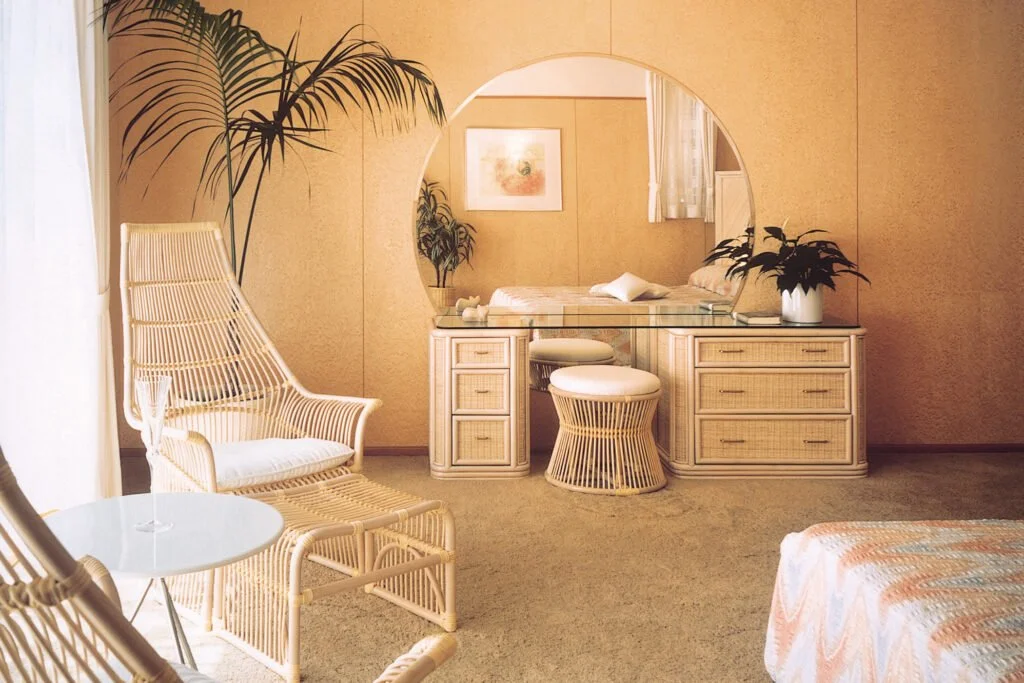Knowing the input raw material
At Trinity Crafts, before we started working on this product line, we too were intrigued as well as less informed. So, we started to dig the secondary resources. Here we are pleased to share some knowledge with you.
Rattan Plant –
Rattan is a naturally renewable palm that mainly grows in the tropical regions of South East Asia, Africa and Australasia. These plants belong to the palm family (Arecales or Palmea). The name ‘Rattan’ comes from Malaysia where it is colloquially called ‘Rotan’ meaning a climber. Its woody, flexible stems make it a ‘Liana’ than a tree. Rattan plants have been known to grow up to hundreds of meters long climbing on the trees or spreading on the ground.
Stems of Rattan plants are cut in the forest and are partially processed before being sold. The ones with small diameters are dried in the sun and often smoked using Sulphur. Large Stems are boiled in oil to make them drier and to protect them from insects. Various methods of preventing insect and fungi infestation are applied at various stages of processing.
There are several types of rattan palms, such as high or low climbers, single stemmed or clustered Rattan species. Some have noticeably short and underground stems. Rattan sheaths have spines for protection, along with ‘whips’ that are also covered with spines. These play a significant role in supporting the Rattan as it grows over trees and other plants in the rainforest.
Indonesia is credited with almost 70% of the world’s Rattan population. With 13 genera and around 600 known species Rattan plants produce one of the hardest and most durable sources of wood for furniture, craft and other products.
20 or so species (especially of the genera Calamus and Daemonorops), which are commercially used, usually grow in hilly tropical areas, with a mean annual temperature of 25° C and an annual rainfall of 2,000 mm. As a result, the main area for Rattan plantation is in the tropical regions of South and Southeast Asia.
Rattan is an attractive resource because it is easier than timber to harvest, easier to transport and grows much faster than trees.
Qualities of Rattan furniture
Rattan is an exceptionally good material to create furniture and products comprising fluid designs incorporating complex, delicate curves. Key strengths of Rattan furniture come from it being durable, strong, lighter in weight, flexible, malleable and suitable for outdoor usage. Light yet strong, tough yet flexible, elegant yet durable, lightly fragrant and easy to maintain over extended periods.
This is one material which easily exhibits the vision, feelings, emotions and tenderness of the artisans crafting it. Rattan reciprocates well to the artistic streaks of the craftsmen.
Adding to its charisma is its ability to accept coatings and paints like many other kinds of good wood. This gives it additional advantage of being able to adopt assorted styles, hues and colours.
Cane –
Like other mature plants Rattan too is endowed with highly usable outer sheath; protective bark. Its strong continuous structure gives it the ability to be peeled into long, sturdy strands. Though usually the whole Rattan stem is referred to as ‘Cane’ in the commercial circles it is the peeled bark that ‘Cane’ refers to.
Thanks to its strength in holding its world together, it is used for binding and keeping other elements together. Cane also is a useful weaving element for the wicker furniture. Being a less porous material Cane easily repels liquids.
Rattan Core –
Rattan Core, also known as Centre-Cane, is the pith of the stem of the plant. While it is cut in shapes such as round, flat, trapezium etc., flat and round cores are mostly used in furniture making. Though these can be produced from various species of Rattan, only a few commercially suitable species provide pliable cores with good finish which do not split, kink, crack or snap during bending or weaving.
Rattan Poles or Stems –
Straightened after harvesting, Rattan stems, colloquially called ‘Canes’ form the main structural element of the products, especially furniture items. These are the plant stems of different lengths used to give strength and structure to the items.
These stems come in varied lengths and diameters. Stems with larger diameter are used as key members of the structures. Thinner stalks are much flexible and are used as straight, bent or curved parts of the items.
Straight Rattan poles bend well when wet, with application of heat. After being bent to desired shapes these are dried before being used in the product. Dried stems permanently retain given shape.
Are Rattan and Bamboo close cousins?
Though usually seen as close relatives, Bamboo and Rattan plants are as different as Melons and Squashes. Already having written about Rattan, hereinabove, it is in place to write a little about ‘Bamboo’ a kind of grass.
Bamboo is from the grass family which can grow quite high on its own, without support. Bamboos too has many species and genera. Some species of Bamboos grow huge, over 30 meters high with diameters of 25-30cm (9-12 inches).
It is worth knowing that, even though classified as grass, some bamboos are harder than Mahogany.
In addition to being used for furniture-making, Bamboo timber is used in many other applications such as houses, flooring, walls, bridges and much more.
For the uninitiated Bamboo is a hollow giant grass, unlike Rattan which has a solid core.
